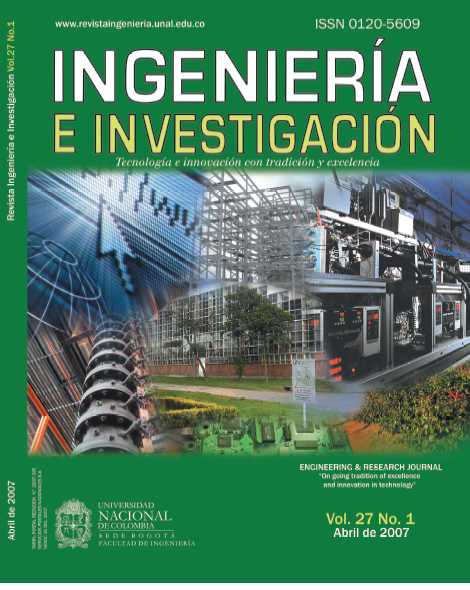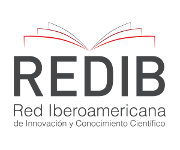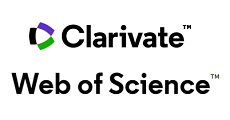Partial oxidation of methane to formaldehyde on MoO3, Fe2O3 and ferromolybdenum catalysts
Oxidación parcial de metano a formaldehido sobre catalizadores de MoO3, Fe2O3 y ferromolibdeno
DOI:
https://doi.org/10.15446/ing.investig.v27n1.14773Keywords:
formaldehyde, methane, ferromolybdenum, ferric oxide, molybdenum oxide, partial oxidation (en)formaldehido, metano, ferromolibdeno, óxido férrico, óxido de molibdeno, oxidación parcial (es)
Downloads
One of the main challenges for catalysis has been direct methane conversion to useful products such as methanol and formaldehyde. Formaldehyde is currently produced by a three-step industrial process with syngas and methanol as intermediate products. MoO3 Fe2O3, and Fe2(MoO4)3 catalysts were used with four different Mo/Fe molar ratios (0.5, 1, 1.5, 2) in this work. The ferromolybdenum catalyst was prepared by coprecipitation. Pure oxides are more active; however they are not formaldehyde selective, but carbon oxide (CO, CO2) selective. The ferromolybdenum catalysts showed better HCHO selectivity at low conversions; the molybdenum oxide content did not show increased in catalytic activity. Increased reaction temperature did not increase formaldehyde selectivity.
Uno de los grandes retos para la catálisis ha sido la conversión directa de metano en productos químicos útiles a la industria tales como metanol y formaldehido. Actualmente el formaldehído es producido en un proceso que involucra tres pasos con gas de síntesis y metanol como productos intermedios. En este trabajo se emplearon catalizadores de MoO3, Fe2O3 y Fe2(MoO4)3 en cuatro proporciones Mo/Fe diferentes (0.5, 1, 1.5, 2). El catalizador de ferromolibdeno fue preparado por coprecipitación. Los óxidos puros presentan mayor actividad; sin embargo, no son selectivos a formaldehído, siendo los óxidos de carbono (CO, CO2) los principales productos. Los catalizadores de ferromolibdeno mejoran la selectividad a HCHO en detrimento del grado de conversión; el contenido de molibdeno no muestra incrementos en la actividad catalítica. El aumento en la temperatura de reacción no genera un aumento en la selectividad a formaldehído.
References
Arena, F., Frusteri, F. and Parmaliana, A., Partial Oxidation of Methane to Formaldehyde a Theoretic-Experimental approach to process design and catalyst development., Journal of Catalysis 207, 2002, pp. 232-236. DOI: https://doi.org/10.1006/jcat.2002.3527
Lunsford, J. H., Catalytic conversion of methane to more useful chemicals and fuels a challenge for the 21st century., Catalysis Today 63, 2000, pp. 165-174. DOI: https://doi.org/10.1016/S0920-5861(00)00456-9
Otsuka, K. and Wang, Y., Direct conversion of methane into oxygenates., Applied Catalysis 222, 2001, pp. 145-161. DOI: https://doi.org/10.1016/S0926-860X(01)00837-7
Sokolovskii, V. D., Coville, N. J., Parmaliana, A., Eskendirov, I. and Makoa, M., Methane partial oxidation. Challenge and perspective., Catalysis Today 42, 1998, pp. 191-195. DOI: https://doi.org/10.1016/S0920-5861(98)00091-1
Takemoto, T., Tabata, K., Teng, Y., Lian-Xin Dai, L. X. and Suzuki, E., Selective oxidation of methane in CH4 - O2 - NO2 over MoO3., Catalysis Today 71, 2001, pp. 5-13. DOI: https://doi.org/10.1016/S0920-5861(01)00441-2
Zhang, Q., He, D. and Zhu, Q., Recent Progress in Direct Partial Oxidation of Methane to methanol., Journal of Natural Gas Chemistry 12, 2003, pp. 81-89.
Herman, R.G., Sun, Q., Shi, C., Klier, K., Wang, C. B., Hu, H., Wachs, I. E. and Bhasin M. M., Development of active catalysts for the direct oxidation of the methane to formaldehyde., Catalysis Today 37, 1997, pp. 1-14. DOI: https://doi.org/10.1016/S0920-5861(96)00256-8
Arena, F., Frusteri, F. and Parmaliana, A., Modeling the Partial oxidation of methane to formaldehyde on silica catalyst., Applied Catalysis 197, 2000, pp. 232-236. DOI: https://doi.org/10.1016/S0926-860X(99)00481-0
Arena, F. and Parmaliana, A., Working Mechanism of Oxide Catalysts in the Partial Oxidation of Methane to for maldehyde., Journal of catalysis 167, 1997, pp. 57-65. DOI: https://doi.org/10.1006/jcat.1997.1545
Arena, F., Gatti, G., Martra, G., Coluccia, S., Stievano, L., Spadaro, L., Famulari, P. and Parmaliana, A., Structure and reactivity in the selective oxidation of methane to formaldehyde of low-loaded FeO X/SiO2 catalysts., Journal of catalysis 231, 2005, pp. 365-380. DOI: https://doi.org/10.1016/j.jcat.2005.01.029
Parmaliana, A., Effect of Fe-addition on the catalytic activity of silicas in the partial oxidation of methane to for maldehyde., Applied Catalysis 226, 2002, pp. 163-174. DOI: https://doi.org/10.1016/S0926-860X(01)00897-3
Parmaliana, A., Arena, F., Sokolovskii, V., Frusteri, F., Giordano, N., A comparative study of the partial oxidation of methane to formaldehyde on bulk and silica supported MoO3 and V2O5 catalyst., Catalysis Today 28, 1996, pp. 363-371. DOI: https://doi.org/10.1016/S0920-5861(96)00049-1
Sánchez, F., Estudio de catalizadores y cinética para la oxidación selectiva de etanol a acetaldehído., Tesis presentada a la Universidad Nacional de Colombia, Facultad de Ingeniería, para optar al grado de Magister Science en Ingeniería Química, Bogotá, 1989.
Del Río, J.D. y Durán, G.A., Oxidación Parcial de Metano a Formaldehído empleando un Catalizador de Ferromolibdeno., Tesis presentada a la Universidad Nacional de Colombia. Facultad de Ingeniería, para optar al título de Ingeniero Químico, Bogotá, 2005.
Soares, A. P. V., Portela, M. F., Kiennemann, A., Hilaire, L. and Millet, J. M. M., Iron molybdate catalysts for methanol to formaldehyde oxidation: effects of Mo excess on catalytic behavior., Applied Catalysis 206, 2001, pp. 221-229. DOI: https://doi.org/10.1016/S0926-860X(00)00600-1
Amiridis, M. D., Rekoske, J. E., Dumesic, J. A., Rudd, D. F., Spencer, N. D. and Pereira, C.J., Simulation of methane partial oxidation over silica-supported MoO3 and V2O5., AIChE Journal, January, Vol. 37, No. 1, 1991. DOI: https://doi.org/10.1002/aic.690370108
How to Cite
APA
ACM
ACS
ABNT
Chicago
Harvard
IEEE
MLA
Turabian
Vancouver
Download Citation
CrossRef Cited-by
1. William Giovanni Cortés-Ortiz, Alexander Baena-Novoa, Carlos Alberto Guerrero-Fajardo. (2019). Structuring-agent role in physical and chemical properties of Mo/SiO2 catalysts by sol-gel method. Journal of Sol-Gel Science and Technology, 89(2), p.416. https://doi.org/10.1007/s10971-018-4892-7.
Dimensions
PlumX
Article abstract page views
Downloads
License
Copyright (c) 2007 José Daniel Del Río, Gustavo Andrés Durán, Álvaro Orjuela Londoño, Francisco José Sánchez Castellanos, Carlos Alberto Guerrero Fajardo

This work is licensed under a Creative Commons Attribution 4.0 International License.
The authors or holders of the copyright for each article hereby confer exclusive, limited and free authorization on the Universidad Nacional de Colombia's journal Ingeniería e Investigación concerning the aforementioned article which, once it has been evaluated and approved, will be submitted for publication, in line with the following items:
1. The version which has been corrected according to the evaluators' suggestions will be remitted and it will be made clear whether the aforementioned article is an unedited document regarding which the rights to be authorized are held and total responsibility will be assumed by the authors for the content of the work being submitted to Ingeniería e Investigación, the Universidad Nacional de Colombia and third-parties;
2. The authorization conferred on the journal will come into force from the date on which it is included in the respective volume and issue of Ingeniería e Investigación in the Open Journal Systems and on the journal's main page (https://revistas.unal.edu.co/index.php/ingeinv), as well as in different databases and indices in which the publication is indexed;
3. The authors authorize the Universidad Nacional de Colombia's journal Ingeniería e Investigación to publish the document in whatever required format (printed, digital, electronic or whatsoever known or yet to be discovered form) and authorize Ingeniería e Investigación to include the work in any indices and/or search engines deemed necessary for promoting its diffusion;
4. The authors accept that such authorization is given free of charge and they, therefore, waive any right to receive remuneration from the publication, distribution, public communication and any use whatsoever referred to in the terms of this authorization.



























